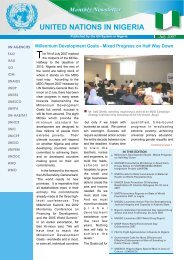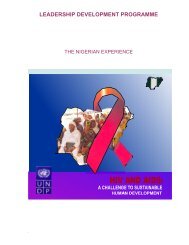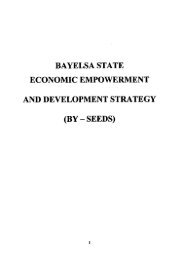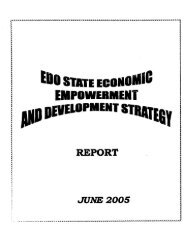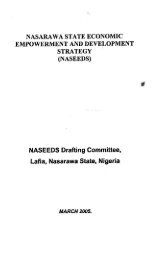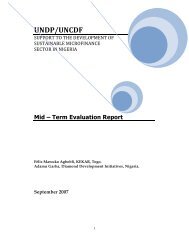Niger Delta Human Development Report - UNDP Nigeria - United ...
Niger Delta Human Development Report - UNDP Nigeria - United ...
Niger Delta Human Development Report - UNDP Nigeria - United ...
Create successful ePaper yourself
Turn your PDF publications into a flip-book with our unique Google optimized e-Paper software.
and reversals in rural capital flows. It<br />
offsets the balance in strategic rural<br />
migration patterns and triggers response<br />
strategies that undermine individual and<br />
community well-being. Community<br />
structures weaken and safety nets are<br />
Chart 4.1: National HIV Prevalence Increase from 1991 to 2003<br />
Box 4.1: The Challenge of HIV&AIDS in Africa<br />
Africa is currently faced with a grave and degenerative crisis under HIV&AIDS.<br />
Available statistics show that nine out of every 10 new cases of HIV occur in Africa.<br />
AIDS is not only “the deadliest epidemic in continental history, but also a major<br />
demographic, humanitarian, and development crisis” (Gaigbe-Togbe and Weinberger<br />
2003: 1).<br />
By the end of 2002, 42 million people worldwide were infected with HIV, with 25<br />
million already dead from AIDS. About 95 per cent of this total is in the less<br />
industrialized world. An estimated 13 million AIDS orphans currently live in sub-<br />
Saharan Africa alone. In 38 African countries (including <strong>Niger</strong>ia), the <strong>United</strong> Nations<br />
Population Division explicitly incorporated the impact of AIDS into its 2002 population<br />
projections. It estimated the total population at 603 million in 1995, with 16 million<br />
fewer people than without AIDS. By 2025, the population of these 38 countries is<br />
projected to reach 983 million, a 14 per cent shortfall.<br />
Average life expectancy at birth has already fallen by 10 years in the most affected<br />
countries—that is, those with an adult HIV prevalence of 20 per cent or more (UN<br />
2003). 2 The 1995-2000 average life expectancy is estimated at 47 years for these<br />
countries, a six-year drop due to AIDS. By 2020-2025, life expectancy is projected to<br />
reach only 52 years, or 10 years less than could otherwise be predicted.<br />
strained. The resilience of farming and<br />
livelihood systems diminishes, vulnerability<br />
to food shortages increases, and<br />
households have less of a capacity to<br />
recover from disasters that occur. In<br />
dealing with the burdens from<br />
HIV&AIDS, people lose time and<br />
opportunities they might otherwise have<br />
had in a world without this disease.<br />
THE PREVALENCE OF HIV&AIDS<br />
IN THE NIGER DELTA<br />
The prevalence of HIV&AIDS in the<br />
<strong>Niger</strong> <strong>Delta</strong> is among the highest in the<br />
country, higher than the average for <strong>Niger</strong>ia<br />
as a whole (see table 4.1 and chart 4.2).<br />
The 2003 sentinel survey rated the South-<br />
South region as having the second highest<br />
prevalence (5.8 per cent), after the North<br />
Central zone with seven per cent. This<br />
result is alarming compared to the South-<br />
West at 2.3 per cent and the North-West<br />
at 4.2 per cent (see chart 4.3). The delta<br />
has an average prevalence rate of 5.3 per<br />
cent, compared to the national average of<br />
94 NIGER DELTA HUMAN DEVELOPMENT REPORT



